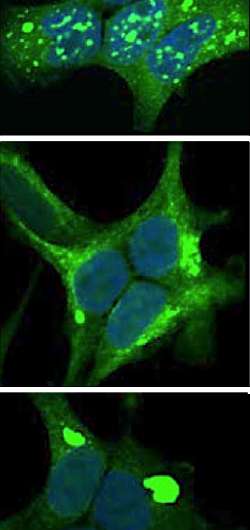Alzheimer's disease, other conditions linked to prion-like proteins

(Medical Xpress)—A new theory about disorders that attack the brain and spinal column has received a significant boost from scientists at Washington University School of Medicine in St. Louis.
The theory attributes these disorders to proteins that act like prions, which are copies of a normal protein that have been corrupted in ways that cause diseases. Scientists previously thought that only one particular protein could be corrupted in this fashion, but researchers in the laboratory of Marc Diamond, MD, report that another protein linked to Alzheimer's disease and many other neurodegenerative conditions also behaves very much like a prion.
The findings appear online May 22 in Neuron.
Diamond's lab found that the protein, known as tau, could be corrupted in different ways, and that these different forms of corruption—known as strains—were linked to distinct forms of damage to the brain.
"If we think of these different tau strains as different pathogens, then we can begin to describe many human disorders linked to tau based on the strains that underlie them," said senior author Diamond, the David Clayson Professor of Neurology. "This may mean that certain antibodies or drugs, for example, will work better against certain disorders than others."
The study was led by co-first authors David Sanders and Sarah Kaufman, who are graduate students.
Prions are composed of normal proteins that have folded into an abnormal shape. They aren't alive, but their effects can be similar to infectious microbes such as bacteria or viruses. Their unusual structure lets prions replicate themselves through a kind of molecular peer pressure: When a prion interacts with identical but normally folded proteins, it can cause these proteins to become prions, which are small aggregates, or clumps, that can spread from cell to cell.
Prions first came to popular attention in the 1990s with the emergence of mad cow disease, a disorder that destroys the brains of cattle. Scientists linked a few cases of a similar condition in people to consumption of meat from infected cows. Researchers eventually determined that the disorder was caused by a distinct strain of prions made by the sickened cattle.
Scientists had suspected that prion-like forms of a protein called alpha-synuclein contribute to Parkinson's disease and other conditions, and prion-like versions of proteins known as SOD1 and TDP43 may cause amyotrophic lateral sclerosis, commonly known as Lou Gehrig's disease.
Scientists also had identified tau clumps in 25 different neurodegenerative disorders, known collectively as tauopathies. This hinted at potential prion-like behavior on the part of tau. In 2009, Diamond's group found that tau misfolds into several different shapes in a test tube.
"When we infected a cell with one of these misshapen copies of tau and allowed the cell to reproduce, the daughter cells contained copies of tau misfolded in the same fashion as the parent cell," Diamond said. "Further, if we extracted the tau from an affected cell, we could reintroduce it to a naïve cell, where it would recreate the same aggregate shape. This proves that each of these differently shaped copies of the tau protein can form stable prion strains, like a virus or a bacteria, that can be passed on indefinitely."
Diamond used the tau prions made in cells to infect mouse brains, showing that differently shaped strains caused different levels of brain damage. He isolated the prions from the mice, grew them in cell culture, and then infected other mice. Throughout these transfers, each particular prion strain continued to be misfolded in the same shape and to cause damage in the same fashion.
Finally, the researchers examined clumps of tau from the brains of 28 patients after they died. Each of the patients was known to have one of five forms of tauopathy.
"Each disease had a unique tau prion strain or combination of strains associated with it," he said. "For example, we isolated the same tau prion strain from nearly every patient with Alzheimer's disease we examined."
Brain samples from patients with the progressive neurological disorderscorticobasal degeneration and Pick's disease also typically had the same tau prion strains or mixtures of strains.
Diamond and others now are working to find a way to isolate tau prions non-invasively from individuals for diagnostic purposes.
Options for stopping prions include monoclonal antibodies, which could label prions for inactivation or immune system attack and removal (described in a paper by Diamond and David Holtzman, MD, Chair of Neurology (Neuron, 2013)). Diamond and others also are developing ways to block tau prion movement between cells and to stop cells from making new copies of the prion proteins.
More information: Sanders DW, Kaufman SK, DeVos SL, Sharma AM, Mirbaha H, Li A, Barker SJ, Foley AC, Thorpe JR, Serpell LC, Miller TM, Grinberg LT, Seeley WW, Diamond ML. "Distinct tau prion strains propagate in cells and mice and define different tauopathies." Neuron, online May 22, 2014. DOI: dx.doi.org/10.1016/j.neuron.2014.04.047















